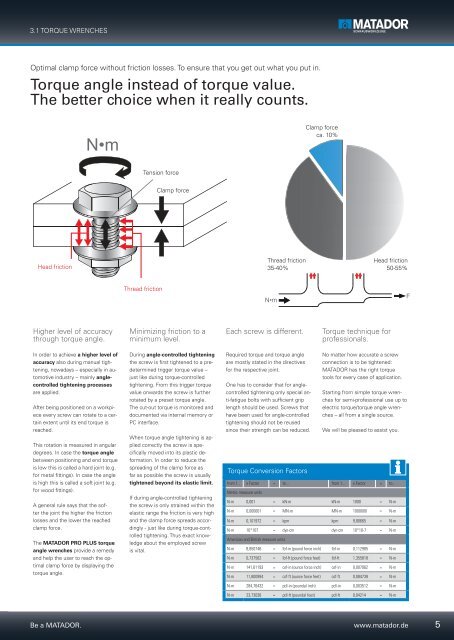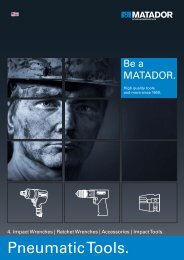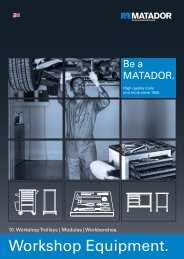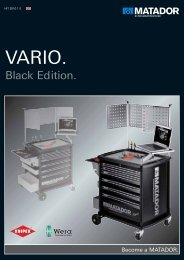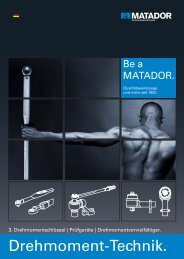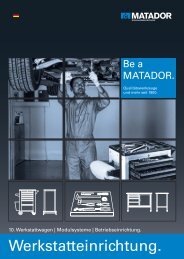Torque Control. - Matador
Torque Control. - Matador
Torque Control. - Matador
Create successful ePaper yourself
Turn your PDF publications into a flip-book with our unique Google optimized e-Paper software.
3.1 TORQUE WRENCHES<br />
Optimal clamp force without friction losses. To ensure that you get out what you put in.<br />
<strong>Torque</strong> angle instead of torque value.<br />
The better choice when it really counts.<br />
Head friction<br />
Higher level of accuracy<br />
through torque angle.<br />
In order to achieve a higher level of<br />
accuracy also during manual tightening,<br />
nowadays – especially in automotive<br />
industry – mainly anglecontrolled<br />
tightening processes<br />
are applied.<br />
After being positioned on a workpiece<br />
every screw can rotate to a certain<br />
extent until its end torque is<br />
reached.<br />
This rotation is measured in angular<br />
degrees. In case the torque angle<br />
between positioning and end torque<br />
is low this is called a hard joint (e.g.<br />
for metal fittings). In case the angle<br />
is high this is called a soft joint (e.g.<br />
for wood fittings).<br />
A general rule says that the softer<br />
the joint the higher the friction<br />
losses and the lower the reached<br />
clamp force.<br />
The MATADOR PRO PLUS torque<br />
angle wrenches provide a remedy<br />
and help the user to reach the optimal<br />
clamp force by displaying the<br />
torque angle.<br />
Be a MATADOR.<br />
Tension force<br />
Thread friction<br />
Clamp force<br />
Minimizing friction to a<br />
minimum level.<br />
During angle-controlled tightening<br />
the screw is first tightened to a predetermined<br />
trigger torque value –<br />
just like during torque-controlled<br />
tightening. From this trigger torque<br />
value onwards the screw is further<br />
rotated by a preset torque angle.<br />
The cut-out torque is monitored and<br />
documented via internal memory or<br />
PC interface.<br />
When torque angle tightening is applied<br />
correctly the screw is specifically<br />
moved into its plastic deformation.<br />
In order to reduce the<br />
spreading of the clamp force as<br />
far as possible the screw is usually<br />
tightened beyond its elastic limit.<br />
If during angle-controlled tightening<br />
the screw is only strained within the<br />
elastic range the friction is very high<br />
and the clamp force spreads accordingly<br />
- just like during torque-controlled<br />
tightening. Thus exact knowledge<br />
about the employed screw<br />
is vital.<br />
Thread friction<br />
35-40%<br />
Each screw is different.<br />
Required torque and torque angle<br />
are mostly stated in the directives<br />
for the respective joint.<br />
One has to consider that for anglecontrolled<br />
tightening only special anti-fatigue<br />
bolts with sufficient grip<br />
length should be used. Screws that<br />
have been used for angle-controlled<br />
tightening should not be reused<br />
since their strength can be reduced.<br />
<strong>Torque</strong> Conversion Factors<br />
Clamp force<br />
ca. 10%<br />
<strong>Torque</strong> technique for<br />
professionals.<br />
Head friction<br />
50-55%<br />
No matter how accurate a screw<br />
connection is to be tightened:<br />
MATADOR has the right torque<br />
tools for every case of application.<br />
Starting from simple torque wrenches<br />
for semi-professional use up to<br />
electric torque/torque angle wrenches<br />
– all from a single source.<br />
We will be pleased to assist you.<br />
from 1.. x Factor = to... from 1... x Factor = to...<br />
Metric measure units<br />
Nm 0,001 = kNm kNm1000 = Nm<br />
Nm 0,000001 = MNm MNm1000000 = Nm<br />
Nm 0,101972 = kpm kpm 9,80665 = Nm<br />
Nm 10*107 = dyncm dyncm 10*10-7 = Nm<br />
American and British measure units<br />
Nm 8,850746 = lbfin (pound force inch) lbfin 0,112985 = Nm<br />
Nm 0,737562 = lbfft (pound force feet) lbfft 1,355818 = Nm<br />
Nm 141,61193 = ozfin (ounce force inch) ozfin 0,007062 = Nm<br />
Nm 11,800994 = ozfft (ounce force feet) ozfft 0,084739 = Nm<br />
Nm 284,76432 = pdlin (poundal inch) pdlin 0,003512 = Nm<br />
Nm 23,73036 = pdlft (poundal feet) pdlft 0,04214 = Nm<br />
www.matador.de 5


